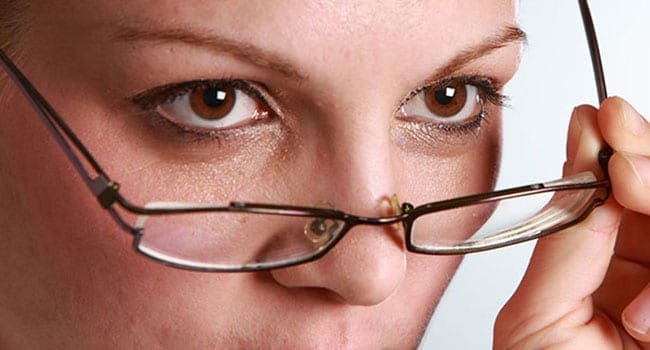 You’re at a business networking event and the colleague you’ve been having an intense conversation with begins to shift her gaze from your face to look around the room. Ever wonder why that makes you feel as if she has stopped listening? You know it’s not logical. A person doesn’t have to look at you to hear you. People don’t listen with their eyes.
You’re at a business networking event and the colleague you’ve been having an intense conversation with begins to shift her gaze from your face to look around the room. Ever wonder why that makes you feel as if she has stopped listening? You know it’s not logical. A person doesn’t have to look at you to hear you. People don’t listen with their eyes.
Or do they?
The impact of eye contact is so powerful because it is instinctive and connected with humans’ early survival patterns. Children who could attract and maintain eye contact, and therefore increase attention, had the best chance of being fed and cared for.
And eye contact retains its power with adults. We gaze intently at one another, unconsciously monitoring the wide eyes of surprise or pleasure and the narrowed eyes of suspicion or dislike. We respond (positively or negatively) to dilated pupils that signal attraction, increased blink rates caused by stress, and darting eyes that underscore discomfort or defensiveness.
Over the course of a conversation, eye contact is made through a series of glances – by the speaker, to make sure the other person has understood or to gauge reactions, and by the listener to indicate interest in either the other person or what’s being said. It is also used as a synchronizing signal. People tend to look up at the end of utterances, which gives their listeners warning that the speaker is about to stop talking. There is often mutual eye contact during attempted interruptions, laughing, and when answering short questions.
The power of eye contact to direct a conversation is evident even when the ‘listener’ is a robot.
Scientists from Carnegie Mellon University, in collaboration with researchers from Japan’s Osaka University and from ATR Intelligent Robotics and Communication Laboratory, found that a robot’s eye movement is key to guiding the flow of a conversation with more than one person. The robot (called Robovie) used for the experiments was given the ability to combine gaze with speech.
Having been programmed to play the part of a travel agent, Robovie was able to control the flow of a booking negotiation quite effectively with strategic eye contact: When it looked equally at two people, they took turns speaking. Those at whom Robovie only glanced spoke less, and those who were ignored completely spoke the least. This pattern was consistent about 97 per cent of the time.
Eye contact is most effective when both parties feel its intensity is appropriate for the situation (and this may differ with introverts/extroverts, men/women, or between different cultures). But greater eye contact, especially in intervals lasting four to five seconds, almost always leads to greater liking. As long as people are looking at us, we believe we have their interest. If they meet our gaze more than two-thirds of the time, we sense that they find us appealing or fascinating.
The only kind of increased eye contact that does not increase liking is staring – which most of us consider to be rude or even threatening. This kind of over-done eye contact generally communicates a desire to dominate, a feeling of superiority, a lack of respect, or a wish to insult.
In the Western world, too little eye contact is interpreted as being impolite, insincere, or even dishonest. One hospital, analyzing letters of complaints from patients, reported that 90 per cent of the complaints had to do with poor doctor eye contact, which was perceived as a ‘lack of caring.’
But people decrease or avoid eye contact for many reasons – when they are discussing something intimate or difficult, when they are not interested in the other person’s reactions, when they don’t like the other person, when they are insecure or shy and when they are ashamed, embarrassed, depressed or sad.
Waiters in restaurants tend to avoid eye contact with their customers to send the message, ‘I’m too busy to deal with you right now.’ Employees avoid eye contact when the boss poses a difficult question or asks for volunteers. (The general rule here is to look down and shuffle through notes as if searching for the answer or engaged in a much more important pursuit.) And when pedestrians or drivers want to ensure their own right of way, one strategy is to avoid meeting the other’s eyes in order to avoid cooperation.
In intense or intimate conversations people naturally look at one another more often and hold that focus for longer periods of time. A sure sign that a conversation is lagging is when one of the participants begins looking away to pay more attention to other people or objects in the vicinity.
So when your business colleague stopped looking at you and began to gaze blankly into the distance or visually scan the room, she was ‘saying’ with her eyes that she had, in effect, stopped listening.
And, by the way, leaders who neglect to make eye contact when members of their teams are speaking send the same negative message of disinterest.
Troy Media columnist Carol Kinsey Goman, PhD, is an executive coach, consultant, and international keynote speaker at corporate, government, and association events. She is also the author of STAND OUT: How to Build Your Leadership Presence.
The views, opinions and positions expressed by columnists and contributors are the author’s alone. They do not inherently or expressly reflect the views, opinions and/or positions of our publication.

